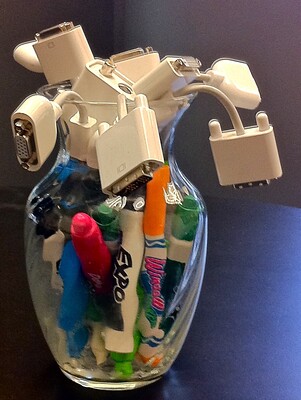Archive for the ‘Business Model’ Category
The Next Evolution of Your Success
 New ways to work are new because they have not been done before.
New ways to work are new because they have not been done before.
How many new ways to work have you demonstrated over the last year?
New customer value is new when it has not been shown before.
What new customer value have you demonstrated over the last year?
New ways to deliver customer value are new when you have not done it that way before.
How much customer value have you demonstrated through non-product solutions?
The success of old ways of working block new ways.
How many new ways to work have been blocked by your success?
The success of old customer value blocks new customer value.
How much new customer value has been blocked by your success with old customer value?
The success of tried and true ways to deliver customer value blocks new ways to deliver customer value.
Which new ways to deliver unique customer value have been blocked by your success?
Might you be more successful if you stop blocking yourself with your success?
How might you put your success behind you and create the next evolution of your success?
Image credit — Andy Morffew
Is the timing right?
 If there is no problem, it is too soon for a solution.
If there is no problem, it is too soon for a solution.
But when there is consensus on a problem, it may be too late to solve it.
If a powerful protector of the Status Quo is to retire in a year, it may be too early to start work on the most important sacrilege.
But if the sacrilege can be done under cover, it may be time to start.
It may be too soon to put a young but talented person in a leadership position if the team is also green.
But it may be the right time to pair the younger person with a seasoned leader and move them both to the team.
When the business model is highly profitable, it may be too soon to demonstrate a more profitable business model that could obsolete the existing one.
But new business models take a long time to gestate and all business models have half-lives, so it may be time to demonstrate the new one.
If there is no budget for a project, it is too soon for the project.
But the budget may never come, so it is probably time to start the project on the smallest scale.
When the new technology becomes highly profitable, it may be too soon to demonstrate the new technology that makes it obsolete.
But like with business models, all technologies have half-lives, so it may be time to demonstrate the new technology.
The timing to do new work or make a change is never perfect. But if the timing is wrong, wait. But don’t wait too long.
If the timing isn’t right, adjust the approach to soften the conflict, e.g., pair a younger leader with a seasoned leader and move them both.
And if the timing is wrong but you think the new work cannot wait, start small.
And if the timing is horrifically wrong, start smaller.
It’s good to have experience, until the fundamentals change.
 We use our previous experiences as context for decisions we make in the present. When we have a bad experience, the experience-context pair gets stored away in our memory so that we can avoid a similar bad outcome when a similar context arises. And when we have a good experience, or we’re successful, that memory-context pair gets stored away for future reuse. This reuse approach saves time and energy and, most of the time keeps us safe. It’s nature’s way of helping us do more of what works and less of what doesn’t.
We use our previous experiences as context for decisions we make in the present. When we have a bad experience, the experience-context pair gets stored away in our memory so that we can avoid a similar bad outcome when a similar context arises. And when we have a good experience, or we’re successful, that memory-context pair gets stored away for future reuse. This reuse approach saves time and energy and, most of the time keeps us safe. It’s nature’s way of helping us do more of what works and less of what doesn’t.
The system works well when we correctly match the historical context with today’s context and the system’s fundamentals remain unchanged. There are two potential failure modes here. The first is when we mistakenly map the context of today’s situation with a memory-context pair that does not apply. With this, we misapply our experience-based knowledge in a context that demands different knowledge and different decisions. The second (and more dangerous) failure mode is when we correctly identify the match between past and current contexts but the rules that underpin the context have changed. Here, we feel good that we know how things will turn out, and, at the same time, we’re oblivious to the reality that our experience-based knowledge is out of date.
“If a cat sits on a hot stove, that cat won’t sit on a hot stove again. That cat won’t sit on a cold stove either. That cat just don’t like stoves.” Mark Twain
If you tried something ten years ago and it failed, it’s possible that the underpinning technology has changed and it’s time to give it another try.
If you’ve been successful doing the same thing over the last ten years, it’s possible that the underpinning business model has changed and it’s time to give a different one a try.
“Hissing cat” by Consumerist Dot Com is licensed under CC BY 2.0.
Problems, Learning, Business Models, and People
 If you know the right answer, you’re working on an old problem or you’re misapplying your experience.
If you know the right answer, you’re working on an old problem or you’re misapplying your experience.
If you are 100% sure how things will turn out, let someone else do it.
If there’s no uncertainty, there can be no learning.
If there’s no learning, your upstart competitors are gaining on you.
If you don’t know what to do, you’ve started the learning cycle.
If you add energy to your business model and it delivers less output, it’s time for a new business model.
If you wait until you’re sure you need a new business model, you waited too long.
Successful business models outlast their usefulness because they’ve been so profitable.
When there’s a project with a 95% chance to increase sales by 3%, there’s no place for a project with a 50% chance to increase sales by 100%.
When progress has slowed, maybe the informal networks have decided slower is faster.
If there’s something in the way, but you cannot figure out what it is, it might be you.
“A bouquet of wilting adapters” by rexhammock is licensed under CC BY-SA 2.0.
Your core business is your greatest strength and your greatest weakness.
 Your core business, the long-standing business that has made you what you are, is both your greatest strength and your greatest weakness.
Your core business, the long-standing business that has made you what you are, is both your greatest strength and your greatest weakness.
The Core generates the revenue, but it also starves fledgling businesses so they never make it off the ground.
There’s a certainty with the Core because it builds on success, but its success sets the certainty threshold too high for new businesses. And due to the relatively high level of uncertainty of the new business (as compared to the Core) the company can’t find the gumption to make the critical investments needed to reach orbit.
The Core has generated profits over the decades and those profits have been used to create the critical infrastructure that makes its success easier to achieve. The internal startup can’t use the Core’s infrastructure because the Core doesn’t share. And the Core has the power to block all others from taking advantage of the infrastructure it created.
The Core has grown revenue year-on-year and has used that revenue to build out specialized support teams that keep the flywheel moving. And because the Core paid for and shaped the teams, their support fits the Core like a glove. A new offering with a new value proposition and new business model cannot use the specialized support teams effectively because the new offering needs otherly-specialized support and because the Core doesn’t share.
The Core pays the bills, and new ventures create bills that the Core doesn’t like to pay.
If the internal startup has to compete with the Core for funding, the internal startup will fail.
If the new venture has to generate profits similar to the Core, the venture will be a misadventure.
If the new offering has to compete with the Core for sales and marketing support, don’t bother.
If the fledgling business’s metrics are assessed like the Core’s metrics, it won’t fly, it will flounder.
If you try to run a new business from within the Core, the Core will eat it.
To work effectively with the Core, borrow its resources, forget how it does the work, and run away.
To protect your new ventures from the Core, physically separate them from the Core.
To protect your new businesses from the Core, create a separate budget that the Core cannot reach.
To protect your internal startup from the Core, make sure it needs nothing from the Core.
To accelerate the growth of the fledgling business, make it safe to violate the Core’s first principles.
To bolster the capability of your new business, move resources from the Core to the new business.
To de-risk the internal startup, move functional support resources from the Core to the startup.
To fund your new ventures, tax the Core. It’s the only way.
“Core Memory” by JD Hancock is licensed under CC BY 2.0
A Recipe to Grow Revenue Now
 If you want to grow the top line right now, create a hard constraint – the product cannot change – and force the team to look for growth outside the product. Since all the easy changes to the product have been made, without a breakthrough the small improvements bring diminishing returns. There’s nothing left here. Make them look elsewhere.
If you want to grow the top line right now, create a hard constraint – the product cannot change – and force the team to look for growth outside the product. Since all the easy changes to the product have been made, without a breakthrough the small improvements bring diminishing returns. There’s nothing left here. Make them look elsewhere.
If you want to grow the top line without changing the product, make it easier for customers to buy the products you already have.
If you want to make it easier for customers to buy what you have, eliminate all things that make buying difficult. Though this sounds obvious and trivial, it’s neither. It’s exceptionally difficult to see the waste in your processes from the customers’ perspective. The blackbelts know how to eliminate waste from the company’s perspective, but they’ve not been taught to see waste from the customers’ perspective. Don’t believe me? Look at the last three improvements you made to the customers’ buying process and ask yourself who benefitted from those changes. Odds are, the changes you made reduced the number of people you need to process the transactions by pushing the work back into the customers’ laps. This is the opposite of making it easier for your customers to buy.
Have you ever run a project to make it easier for customers to buy from you?
If you want to make it easier for customers to buy the products you have, pretend you are a customer and map their buying process. What you’ll likely learn is that it’s not easy to buy from you.
How can you make it easier for the customer to choose the right product to buy? Please don’t confuse this with eliminating the knowledgeable people who talk on the phone with customers. And, fight the urge to display all your products all at once. Minimize their choices, don’t maximize them.
How can you make it easier for customers to buy what they bought last time? A hint: when an existing customer hits your website, the first thing they should see is what they bought last time. Or, maybe, a big button that says – click here to buy [whatever they bought last time]. This, of course, assumes you can recognize them and can quickly match them to their buying history.
How can you make it easier for customers to pay for your product? Here’s a rule to live by: if they don’t pay, you don’t sell. And here’s another: you get no partial credit when a customer almost pays.
As you make these improvements, customers will buy more. You can use the incremental profits to fund the breakthrough work to obsolete your best products.
“Shopping Cart” by edenpictures is licensed under CC BY 2.0
When your company looks in the mirror, what does it see?
 There are many types of companies, and it can be difficult to categorize them. And even within the company itself, there is disagreement about the company’s character. And one of the main sources of disagreement is born from our desire to classify our company as the type we want it to be rather than as the type that it is.
There are many types of companies, and it can be difficult to categorize them. And even within the company itself, there is disagreement about the company’s character. And one of the main sources of disagreement is born from our desire to classify our company as the type we want it to be rather than as the type that it is.
Here’s a process that may bring consensus to your company.
For all the people on the payroll, assign a job type and tally them up for the various types. If most of your people work in finance, you work for a finance company. If most work in manufacturing, you work for a manufacturing company. The same goes for sales, engineering, customer service, consulting. Write your answer here __________.
For all the company’s profits, assign a type and roll up the totals. If most of the profit is generated through the sale of services, you work for a service company. If most of the profit is generated by the sale of software, you work for a software company. If hardware generates profits, you work for a hardware company. If licensing of technology generates profits, you work at a technology company. Which one fits your company best? Write your answer here _________.
For all the people on the payroll, decide if they work to extend and defend the core offerings (the things that you sell today) or create new offerings in new markets that are sold to new customers. If most of the people work on the core offerings, you work for a low-growth company. If most of the people work to create new offerings (non-core), you work for a high-growth company. Which fits you best – extend and defined the core / low-growth or new offerings / high growth? Write your answer here __________ / ___________.
Now, circle your answers below.
We are a (finance, manufacturing, sales, engineering, customer service, consulting) company that generates most of its profits through the sale of (services, hardware, software, technology). And because most of our people work to (extend and defend the core, create new offerings), we are a (low, high) growth company.
To learn what type of company you work for, read the sentences out loud.
“Grace – Mirror” by phil41dean is licensed under CC BY 2.0
What should we do next?
 Anonymous: What do you think we should do next?
Anonymous: What do you think we should do next?
Me: It depends. How did you get here?
Anonymous: Well, we’ve had great success improving on what we did last time.
Me: Well, then you’ll likely do that again.
Anonymous: Do you think we’ll be successful this time?
Me: It depends. If the performance/goodness has been flat over your last offerings, then no. When performance has been constant over the last several offerings it means your technology is mature and it’s time for a new one. Has performance been flat over the years?
Anon: Yes, but we’ve been successful with our tried-and-true recipe and the idea of creating a new technology is risky.
Me: All things have a half-life, including successful business models and long-in-the-tooth technologies, and your success has blinded you to the fact that yours are on life support. Developing a new technology isn’t risky. What’s risk is grasping tightly to a business model that’s out of gas.
Anon: That’s harsh.
Me: I prefer “truthful.”
Anon: So, we should start from scratch and create something altogether new?
Me: Heavens no. That would be a disaster. Figure out which elements are blocking new functionality and reinvent those. Hint: look for the system elements that haven’t changed in a dog’s age and that are shared by all your competitors.
Anon: So, I only have to reinvent several elements?
Me: Yes, but probably fewer than several. Probably just one.
Anon: What if we don’t do that?
Me: Over the next five years, you’ll be successful. And then in year six, the wheels will fall off.
Anon: Are you sure?
Me: No, they could fall off sooner.
Anon: How do you know it will go down like that?
Me: I’ve studied systems and technologies for more than three decades and I’ve made a lot of mistakes. Have you heard of The Voice of Technology?
Anon: No.
Me: Well, take a bite of this – The Voice of Technology. Kevin Kelly has talked about this stuff at great length. Have you read him?
Anon: No.
Me: Here’s a beauty from Kevin – What Technology Wants. How about S-curves?
Anon: Nope.
Me: Here’s a little primer – Beyond Dead Reckoning. How about Technology Forecasting?
Anon: Hmm. I don’t think so.
Me: Here’s something from Victor Fey, my teacher. He worked with Altshuller, the creator of TRIZ – Guided Technology Evolution. I’ve used this method to predict several industry-changing technologies.
Anon: Yikes! There’s a lot here. I’m overwhelmed.
Me: That’s good! Overwhelmed is a sign you realize there’s a lot you don’t know. You could be ready to become a student of the game.
Anon: But where do I start?
Me: I’d start Wardley Maps for situation analysis and LEANSTACK to figure out if customers will pay for your new offering.
Anon: With those two I’m good to go?
Me: Hell no!
Anon: What do you mean?
Me: There’s a whole body of work to learn about. Then you’ve got to build the organization, create the right mindset, select the right projects, train on the right tools, and run the projects.
Anon: That sounds like a lot of work.
Me: Well, you can always do what you did last time. END.
“he went that way matey” by jim.gifford is licensed under CC BY-SA 2.0
The Power of Prototypes
 A prototype moves us from “That’s not possible.” to “Hey, watch this!”
A prototype moves us from “That’s not possible.” to “Hey, watch this!”
A prototype moves us from “We don’t do it that way.” to “Well, we do now.”
A prototype moves us from “That’s impossible.” to “As it turns out, it was only almost impossible.”
A prototype turns naysayers into enemies and profits.
A prototype moves us from an argument to a new product development project.
A prototype turns analysis-paralysis into progress.
A prototype turns a skeptical VP into a vicious advocate.
A prototype turns a pet project into top-line growth.
A prototype turns disbelievers into originators of the idea.
A prototype can turn a Digital Strategy into customer value.
A prototype can turn an uncomfortable Board of Directors meeting into a pizza party.
A prototype can save a CEO’s ass.
A prototype can be too early, but mostly they’re too late.
If the wheels fall off your first prototype, you’re doing it right.
If your prototype doesn’t dismantle the Status-Quo, you built the wrong prototype.
A good prototype violates your business model.
A prototype doesn’t care if you see it for what it is because it knows everyone else will.
A prototype turns “I don’t believe you.” into “You don’t have to.”
When you’re told “Don’t make that prototype.” you’re onto something.
A prototype eats not-invented-here for breakfast.
A prototype can overpower the staunchest critic, even the VP flavor.
A prototype moves us from “You don’t know what you’re talking about.” to “Oh, yes I do.”
If the wheels fall off your second prototype, keep going.
A prototype is objective evidence you’re trying to make a difference.
You can argue with a prototype, but you’ll lose.
If there’s a mismatch between the theory and the prototype, believe the prototype.
A prototype doesn’t have to do everything, but it must do one important thing for the first time.
A prototype must be real, but it doesn’t have to be really real.
If your prototype obsoletes your best product, congratulations.
A prototype turns political posturing into reluctant compliance and profits.
A prototype turns “What the hell are you talking about?” into “This.”
A good prototype bestows privilege on the prototyper.
A prototype can beat a CEO in an arm-wrestling match.
A prototype doesn’t care if you like it. It only cares about creating customer value.
If there’s an argument between a well-stated theory and a well-functioning prototype, it’s pretty clear which camp will refine their theory to line up with what they just saw with their own eyes.
A prototype knows it has every right to tell the critics to “Kiss my ass.” but it knows it doesn’t have to.
You can argue with a prototype, but shouldn’t.
A prototype changes thinking without asking for consent.
Image credit — Pedro Ribeiro Simões
Want to succeed? Learn how to deliver customer value.
 Whatever your initiative, start with customer value. Whatever your project, base it on customer value. And whatever your new technology, you guessed it, customer value should be front and center.
Whatever your initiative, start with customer value. Whatever your project, base it on customer value. And whatever your new technology, you guessed it, customer value should be front and center.
Whenever the discussion turns to customer value, expect confusion, disagreement, and, likely, anger. To help things move forward, here’s an operational definition I’ve found helpful:
When they buy it for more than your cost to make it, you have customer value.
And when there’s no way to pull out of the death spiral of disagreement, use this operational definition to avoid (or stop) bad projects:
When no one will buy it, you don’t have customer value and it’s a bad project.
As two words, customer and value don’t seem all that special. But, when you put them together, they become words to live by. But, also, when you do put them together, things get complicated. Here’s why.
To provide customer value, you’ve got to know (and name) the customer. When you asked “Who is the customer?” the wheels fall off. Here are some wrong answers to that tricky question. The Board of Directors is the customer. The shareholders are the customers. The distributor is the customer. The OEM that integrates your product is the customer. And the people that use the product are the customer. Here’s an operational definition that will set you free:
When someone buys it, they are the customer.
When the discussions get sticky, hold onto that definition. Others will try to bait you into thinking differently, but don’t bite. It will be difficult to stand your ground. And if you feel the group is headed in the wrong direction, try to set things right with this operational definition:
When you’ve found the person who opens their wallet, you’ve found the customer.
Now, let’s talk about value. Isn’t value subjective? Yes, it is. And the only opinion that matters is the customer’s. And here’s an operational definition to help you create customer value:
When you solve an important customer problem, they find it valuable.
And there you have it. Putting it all together, here’s the recipe for customer value:
- Understand who will buy it.
- Understand their work and identify their biggest problem.
- Solve their problem and embed it in your offering.
- Sell it for more than it costs you to make it.
Image credit — Caroline
The Five Hardships of Success
 Everything has a half-life, but we don’t behave that way. Especially when it comes to success. The thinking goes – if it was successful last time, it will be successful next time. So, do it again. And again. It’s an efficient strategy – the heavy resources to bring it to life have already been spent. And it’s predictable – the same customers, the same value proposition, the same supply base, the same distribution channel, and the same technology. And it’s dangerous.
Everything has a half-life, but we don’t behave that way. Especially when it comes to success. The thinking goes – if it was successful last time, it will be successful next time. So, do it again. And again. It’s an efficient strategy – the heavy resources to bring it to life have already been spent. And it’s predictable – the same customers, the same value proposition, the same supply base, the same distribution channel, and the same technology. And it’s dangerous.
Success is successful right up until it isn’t. It will go away. But it will take time. A successful product line won’t fall off the face of the earth overnight. It will deliver profits year-over-year and your company will come to expect them. And your company will get hooked on the lifestyle enabled by those profits. And because of the addiction, when they start to drop off the company will do whatever it takes to convince itself all is well. No need to change. If anything, it’s time to double-down on the successful formula.
Here’s a rule: When your successful recipe no longer brings success, it’s not time to double-down.
Success’s decline will be slow, so you have time. But creating a new recipe takes a long time, so it’s time to declare that the decline has already started. And it’s time to learn how to start work on the new recipe.
Hardship 1 – Allocate resources differently. The whole company wants to spend resources on the same old recipes, even when told not to. It’s time to create a funding stream that’s independent of the normal yearly planning cycle. Simply put, the people at the top have to reallocate a part of the operating budget to projects that will create the next successful platform.
Hardship 2 – Work differently. The company is used to polishing the old products and they don’t know how to create new ones. You need to hire someone who can partner with outside companies (likely startups), build internal teams with a healthy disrespect for previous success, create mechanisms to support those teams and teach them how to work in domains of high uncertainty.
Hardship 3 – See value differently. How do you provide value today? How will you provide value when you can’t do it that way? What is your business model? Are you sure that’s your business model? Which elements of your business model are immature? Are you sure? What is the next logical evolution of how you go about your business? Hire someone to help you answer those questions and create projects to bring the solutions to life.
Hardship 4 – Measure differently. When there’s no customer, no technology and no product, there’s no revenue. You’ve got to learn how to measure the value of the work (and the progress) with something other than revenue. Good luck with that.
Hardship 5 – Compensate differently. People that create something from nothing want different compensation than people that do continuous improvement. And you want to move quickly, violate the status quo, push through constraints and create whole new markets. Figure out the compensation schemes that give them what they want and helps them deliver what you want.
This work is hard, but it’s not impossible. But your company doesn’t have all the pieces to make it happen. Don’t be afraid to look outside your company for help and partnership.
Image credit — Insider Monkey
 Mike Shipulski
Mike Shipulski